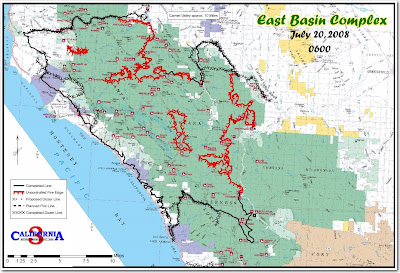One was written by a reporter who for the first time got an aerial view of a fire, in this case the fires near Chico and Paradise in California. He was surprised at some of the things he saw.
Defensible space around a home is critical. Almost without fail, wherever only a foundation was left of a home, it was surrounded by the black spindles of what were once trees. People who enjoy the seclusion that those conifers provide are playing with matches. Firefighters were also at a disadvantage trying to protect homes in an area with no street lights, no paved roads and few street signs.
There's a lot of well-tended marijuana up there. Some people looked like their spent more time on defensible space for their pot garden than for their home.
The other was written by a 7-year firefighter with the Southern Marin Fire Protection District, again in California. In an very well-written article he tells some stories about some of his experiences on large wildland fires:
"You stand here and I'll be right behind you," my captain told me. "Anything goes south and we retreat to the safety zone 50 feet behind us, in front of the engine. Got it?"Basin fireI nodded as I realized that my captain had a great shield from the heat: me.
The winds in our microclimate pushed toward us. A flaming jack rabbit ran past us, getting nothing more than a curious glance. The sandy soil was spraying against my goggles, and I was trying to filter out as much particulate from the air as I could through my sweaty bandana before I polluted my lungs some more.
The air was a mixture of unburned grass, smoke, haze and visual distortion from the heat waves. We were front and center to see nature at her worst.
Then we caught a break as the fire banked to our right, hitting the other engines harder than us. We doused the area around the equipment and headed back to help out the other guys.
After all was said and done, we stood and watched the fire pass by, and immediately heard the radios pick up again as we listened to a strike team get burned more than a mile from our position. Two guys with moderate burns were flown to Salt Lake City. That fire would burn about 12,000 acres of high desert brush in just over six hours.
The Basin fire in the Big Sur area of California is now 133,709 acres and is 70% contained. A fresh incident management team, Jeanne Pincha-Tulley's, assumed command of the fire at 6 p.m. on Saturday and more information is now available for the public. This map is current as of 6 a.m. this morning.
 The map shows that the firefighters have completed firing out from the dozer lines around the White Oaks slopover north of the Mira Observatory. One of the higher priorities they are working on now is burning out from the dozer lines just north of Arroyo Seco.
The map shows that the firefighters have completed firing out from the dozer lines around the White Oaks slopover north of the Mira Observatory. One of the higher priorities they are working on now is burning out from the dozer lines just north of Arroyo Seco.Saturday night's update:
Successful burnout operations continued today on the western edge of the fire between Piney Creek and Arroyo Seco west of Carmel Valley Road, and east of Devil's Peak on the north edge of the fire. Burning operations will continue into the night.




No comments:
Post a Comment